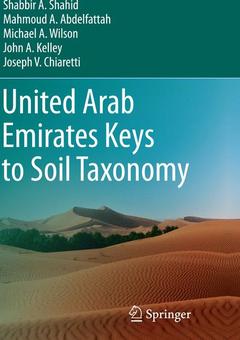Description
United Arab Emirates Keys to Soil Taxonomy, 2014
Authors: Shahid Shabbir A., Abdelfattah Mahmoud A., Wilson Michael A., Kelley John A., Chiaretti Joseph V.
Language: English
Approximative price 98.58 €
In Print (Delivery period: 15 days).
Add to cartPublication date: 09-2016
Support: Print on demand
Approximative price 105.49 €
In Print (Delivery period: 15 days).
Add to cartPublication date: 01-2014
108 p. · 14.8x21 cm · Hardback
Description
/li>Contents
/li>Comment
/li>
Chapter 1 Soil Classification
1.1 Introduction
Chapter 2 The Soils That We Classify
2.1 Introduction
2.2 Buried Soils
2.3 Approach to Soil Classification
2.4 Naming Subgroups
Chapter 3 Horizons, Layers, and Characteristics Diagnostic for the Higher Categories
3.1 Introduction
3.2 Master Horizons and Layers
3.3 Suffix Symbols
3.4 Conventions for Using Letter Suffixes
3.5 Vertical Subdivisions
3.6 Discontinuities
3.7 Use of the Prime Symbol
3.8Use of the Caret Symbol.
3.9 Diagnostic Surface Horizons.
3.9.1 The Epipedon
3.9.1.1 Ochric Epipedon
3.10 Diagnostic Subsurface Horizons
3.10.1 Anhydritic Horizon
3.10.2 Calcic Horizon
3.10.3 Cambic Horizon
3.10.4 Gypsic Horizon
3.10.5 Petrocalcic Horizon
3.10.6 Petrogypsic Horizon
3.10.7 Salic Horizon.
3.11 Horizons and Characteristics-Diagnostics of Mineral Soils
3.11.1 Aquic Conditions
3.11.2 Lithic Contact
3.11.3 Paralithic Contact
3.11.4 Paralithic materials
3.11.5 Soil Moisture Regimes
3.11.5.1 Classes of Soil Moisture Regimes
3.11.6 Soil Temperature Regime
Chapter 4 Family and Series Differentiae
4.1 Introduction
4.2 Definition of Particle-Size Classes
4.2.1 Control Section for Particle-Size Classes
4.2.1.1 Root-Limiting Layers
4.2.1.2 Key to Control Section for Particle-Size Classes
4.2.1.3 Key to the Particle-Size Classes.
4.2.2 Strongly Contrasting Particle Size Classes
4.3 Mineralogy Classes
4.3.1 Control Section for Mineralogy Classes
4.3.2 Key to Mineralogy Classes
4.4 Cation-Exchange Activity Classes
4.4.1 Control Section for Cation-Exchange Activity Classes
4.4.2 Key to Cation-Exchange Activity Classes
4.5 Soil Temperature Classes
4.5.1 Control Section for Soil Temperature
4.6 Soil Depth Classes.
4.6.1 Key to Soil Depth Classes
4.7 Phases of Soil Taxa
4.7.1 Key to Phases
Chapter 5 Identification of the Taxonomic Class of a Soil
5.1 Introduction.
5.2 Key to Soil Orders
5.3 Key to Suborders of Aridisols
5.3.1 Calcids.
5.3.1.1 Haplocalcids
5.3.1.2 Petrocalcids
5.3.2 Cambids
5.3.2.1 Haplocambids
5.3.3 Gypsids
5.3.3.1 Calcigypsids
5.3.3.2 Haplogypsids
5.3.3.3 Petrogypsids
5.3.4 Salids
5.3.4.1 Aquisalids
5.3.4.2 Haplosalids
5.4 Key to the Suborders of Entisols
5.4.1 Aquents.
5.4.1.1 Psammaquents
5.4.2 Orthents
5.4.2.1 Torriorthents
5.4.3 Psamments
5.4.3.1 Torripsamments
Chapter 6 Laboratory Methods for Classification of United Arab Emirates Soils
6.1 Introduction
6.1.1 Soil texture
6.1.2 Fragments in the soil
6.1.3 Moisture content
6.1.4 Total pretreatment loss (TPL)
6.1.5 Loss on acid treatment (LAT)
6.1.6 Carbonate equivalents
6.1.7 Gypsum
6.1.8 Anhydrite.
6.1.9 Extractable cations
6.1.10 Cation-exchange-capacity (CEC)
6.1.11 Exchangeable sodium percentage (ESP)
6.1.12 Saturation percentage (SP)
6.1.13 Saturation extract analysis
6.1.14 Electrical conductivity of the saturated extract (ECe)
6.1.15 Soil reaction or hydrogen ion activity (pH)
6.1.16 Sodium adsorption ratio (SAR)
6.1.17 Osmotic potential (OP)
6.1.18 Engineering data
6.1.19 Atterberg limits
6.1.20 AASHTO group classification
6.1.21 Unified Soil Classification System (USCS)
6.1.22 Percent passing sieves
6.1.23 Water retention (WR)
6.1.24 Water retention difference (WRD)
6.1.25 Bulk density (BD)
6.1.26 Particle density (PD)
6.1.27 Porosity.
6.1.28 Organic carbon (OC)
6.1.29 Soil mineralogy (XRD analysis).
6.1.30 Clay mineralogy (CM)
6.1.31 X-ray fluorescence (XRF)
6.1.32 Thin section study (soil micromorphology)
Chapter 7 Soil Families and Soil Series of the United Arab Emirates
7.1 Introduction
Subject Index
Provides a unique key for classifying soils of the United Arab Emirates
Goes beyond USDA soil classification keys to include specialized criteria for UAE soils
Includes a mechanism for updating current surveys and correlating information from new surveys
Includes supplementary material: sn.pub/extras
These books may interest you

The Soils of Nepal 158.24 €

The Soils of Greece 126.59 €

The Soils of Taiwan 105.49 €

